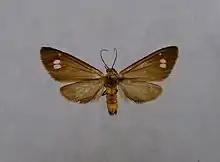Dysauxes ancilla
Dysauxes ancilla, the handmaid, is a moth of the family Erebidae. The species was first described by Carl Linnaeus in his 1767 12th edition of Systema Naturae. It lives in southern and central Europe, through Turkey and Armenia, over the Ural Mountains and up to the Caucasus.
| Dysauxes ancilla | |
|---|---|
 | |
| Scientific classification | |
| Kingdom: | Animalia |
| Phylum: | Arthropoda |
| Class: | Insecta |
| Order: | Lepidoptera |
| Superfamily: | Noctuoidea |
| Family: | Erebidae |
| Subfamily: | Arctiinae |
| Genus: | Dysauxes |
| Species: | D. ancilla |
| Binomial name | |
| Dysauxes ancilla | |
| Synonyms | |
| |
The wingspan is 22–25 mm.
The larvae primarily feed on Taraxacum, Senecio, Plantago and Lactuca species.
External links
| Wikimedia Commons has media related to Dysauxes ancilla. |
| Wikispecies has information related to Dysauxes (Dysauxes) ancilla. |
- Kimber, Ian. "72.0344 BF2071 The Handmaid Dysauxes ancilla (Linnaeus, 1767)". UKMoths. Retrieved 30 June 2019.
- Fauna Europaea
- Lepiforum e. V.
This article is issued from Wikipedia. The text is licensed under Creative Commons - Attribution - Sharealike. Additional terms may apply for the media files.